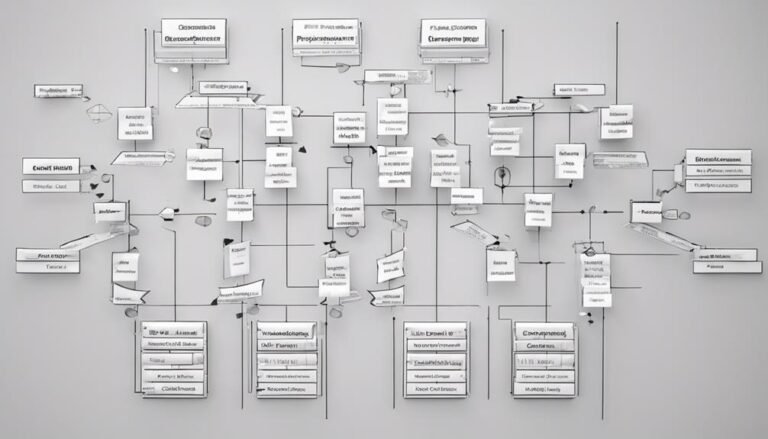Understanding Fixed Assets: Key Concepts and Examples
Understanding fixed assets is essential as they are long-term tangible resources important for operational stability, production support, and revenue generation. They include property, plant, equipment, land, buildings, machinery, vehicles, and furniture, recorded at cost with potential depreciation. Depreciation methods like Straight Line and MACRS impact tax deductions. Asset management strategies involve tracking, maintenance, and minimizing risks. Real-life examples show how fixed assets contribute to organizational growth. grasping these concepts is necessary for effective financial management and decision-making. It provides a foundation to enhance operational efficiency and strategic planning in organizations.
Key Takeaways
- Fixed assets are long-term tangible assets that provide stability and support production processes.
- Types include property, plant, equipment, land, buildings, machinery, vehicles, and furniture.
- Depreciation methods like Straight Line and MACRS help allocate costs over the useful life.
- Asset tracking and clear capital expenditure policies streamline operations and reduce risks.
- Real-life examples involve asset valuation, capital expenditures, and expansion projects impacting financial health.
Importance of Fixed Assets
Fixed assets play an essential role in a company’s financial health by representing long-term tangible assets that are necessary for operations and income generation.
The significance of fixed assets lies in their longevity benefits, as they are expected to last, be consumed, or converted into cash after at least one year. These assets provide stability to a firm’s operations by supporting production processes and facilitating revenue generation over extended periods.
Types of Fixed Assets
Within corporate accounting, the categorization of fixed assets encompasses various tangible resources essential for long-term operational sustainability and revenue generation. Fixed asset categories include property, plant, equipment (PP&E), land, buildings, machinery, vehicles, and furniture.
These assets play an important role in supporting the production process, providing necessary infrastructure, and aiding in the delivery of goods and services. Fixed asset acquisitions involve the initial purchase or construction of these assets, adding value to the organization. Such acquisitions are typically recorded at cost and may undergo depreciation over their useful life.
Proper management of fixed asset categories and acquisitions is crucial for maintaining accurate financial reporting and ensuring the organization’s long-term success.
Depreciation Methods for Fixed Assets
The management of fixed assets involves selecting appropriate depreciation methods to accurately reflect the assets’ diminishing value over time in financial statements. Two common depreciation methods used are the Straight Line method and the Modified Accelerated Cost Recovery System (MACRS) method.
| Depreciation Method | Description |
|---|---|
| Straight Line | Allocates the asset’s cost evenly over its useful life. It is simple and provides a consistent expense each year. |
| MACRS Depreciation | Accelerates depreciation deductions, commonly used for tax purposes. Assets are depreciated based on specified percentages over a predetermined number of years. This method allows for larger depreciation deductions in the earlier years of the asset’s life. |
Fixed Assets Management Strategies
Implementing effective strategies for managing long-term tangible assets is essential for maximizing operational efficiency and financial performance within an organization. Asset tracking plays a vital role in monitoring the location, condition, and maintenance schedules of fixed assets.
By utilizing advanced asset tracking systems, companies can streamline operations, reduce asset downtime, and minimize the risk of theft or loss. Additionally, establishing clear capital expenditure policies helps in determining when and how to invest in fixed assets. By carefully evaluating capital expenditure decisions, organizations can allocate resources efficiently, optimize asset utilization, and guarantee long-term sustainability.
Effective fixed asset management strategies contribute to enhancing productivity, reducing costs, and ultimately driving profitability for the business.
Real-Life Examples of Fixed Assets
To exemplify the principles of effective fixed asset management, real-life instances of fixed assets in various industries shed light on their tangible applications within operational contexts.
Asset valuation plays a vital role in determining the worth of fixed assets such as buildings, machinery, and vehicles. For instance, a manufacturing company may value its production equipment based on market prices and depreciation schedules.
Capital expenditure, another key aspect, involves significant investments in fixed assets to improve business operations. An example would be a retail chain expanding its store network by acquiring new properties and renovating existing ones.
These real-life scenarios highlight how asset valuation and capital expenditure decisions impact the financial health and growth of organizations.
Conclusion
To sum up, fixed assets play a vital role in a company’s financial stability and long-term growth. Understanding the various types of fixed assets, depreciation methods, and management strategies is essential for stakeholders in making informed decisions.
One interesting statistic to note is that according to a study by Deloitte, fixed assets typically make up around 50-70% of a company’s total assets, highlighting their significant impact on the overall financial health of an organization.







